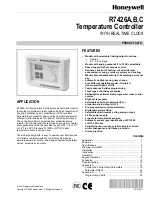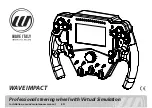
R7426A,B,C TEMPERATURE CONTROLLER
5
63-2564—1
Fig. 4. R7426C typical wiring.
INTRODUCTION
The R7426A,B, or C with remote time clock can be used for a
wide variety of applications:
— R7426A, with a single floating output, can be configured to:
— Control a floating actuator.
— Stage up to three two-position actuators (using relays).
— In either case, it can be configured for heating or
cooling or auto-changeover with external input.
— R7426B, with three floating outputs, can be configured to:
— Stage (on/off) up to six relays in any of the following
combinations: 6-heat, 6-cool, 4-heat/2-cool,
4-cool/2-heat.
— Sequence (using floating outputs) up to 3 actuators in
any of the following combinations: 3 heat, 3 cool,
2-heat/1-cool, or 2-cool/1-heat.
— Control heating (up to 3-stage or floating), cooling (up
to 3-stage or floating), and mixed air damper using the
built in algorithm with adjustable parameters.
— R7426C, with three 0/2-10 Vdc outputs, can be configured to:
— Sequence up to 3 actuators in any of the following
combinations: 3 heat, 3 cool, 2 heat/1 cool, or
2 cool/1 heat.
— Control heating, cooling, and a mixed air damper, all
with 2-10 Vdc outputs.
NOTE: The R7426C cannot stage outputs like the R7426B.
All of the above configurations are handled in parameters
C.08, C.09, C.10, and C.11 (see Table 14). The O1, O2, and
O3 referenced in these parameters simply identify the
actuator outputs that are shown in the wiring diagrams.
To aid in understanding the R7426, Honeywell recommends:
1.
Look at the wiring diagrams (Fig. 2 through 4) to see the
inputs and outputs.
NOTE: These figures show floating or analog outputs
only. If wiring for staged control, see Table 7.
2.
After understanding the wiring, read through the control
and configuration parameters one at a time (see Tables
13 and 14). An explanation for each follows these tables.
3.
Read through the Operation section, referencing the
wiring diagrams and parameter tables as needed.
OPERATION
R7426A Main Temperature Control
The controller compares the main sensor temperature
measured (I01) with the calculated setpoint (CTRP1) to
generate an internal deviation signal (X
W
).
NOTES: The value of
CTRP1
is affected by:
—
OAT compensation effect.
—
CPA.
—
Setback (mode-dependant).
The control output value (O1) is calculated and converted to a
floating signal based on the deviation signal. The configuration
parameter
O1CRTF
selects cooling or heating action. The
throttling range setting (Xp1) controls output span. The
startpoint (O
start
) determines O1 midrange shift (in degrees
Fahrenheit) from
CTRP1
.
NOTES:
—
All diagrams show proportional control action
only. If P+I control is in operation, the slopes for
heating and cooling are not fixed.
—
For control output function see Fig. 5.
Limit
Control (W
lim
, Xp2 and tr2)
The R7426A offers limit control (W
lim
). It compares main and
limit control loop deviation signals. The lowest (low-limit
control) or highest (high-limit control) deviation signal is
selected and fed to the output stage.
25
15
16
17
18
19
20
21
22
23
24
26
27
28
R7426C
M17445A
3
2
11
1
2
3
4
5
6
7
8
9
10
12
OFF
ALARM
NORMAL
ON
13
14
1
2
3
POWER SUPPLY. PROVIDE DISCONNECT
MEANS AND OVERLOAD PROTECTION
AS REQUIRED.
TERMINALS 9 AND 10 ARE THE 24V
DIGITAL (FAN, PUMP) OUTPUT.
TERMINALS 13 AND 14 ARE A SERIAL
INTERFACE FOR A PANEL BUS.
L1
L2
1
+
IO1
CPA/SPA
0/2 TO 10 Vdc
OUTPUT
0/2 TO 10 Vdc
OUTPUT
0/2 TO 10 Vdc
OUTPUT
UNOCCUPIED
FREEZE
PROTECTION
OCCUPIED
MAIN
TEMPERATURE
SENSOR
LIMIT OR
CASCADE
SENSOR
COMPENSATION
SENSOR
+
+
+
+
IO2
O1
O2
O3
+
IO3
HONEYWELL
SERIES 70
ACTUATOR
HONEYWELL
SERIES 70
ACTUATOR
HONEYWELL
SERIES 70
ACTUATOR






































